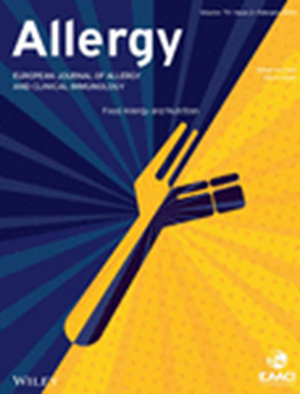Langerhans Cell Modulation in Atopic Dermatitis Is TLR2/SOCS1‐Dependent and JAK Inhibitor‐Sensitive
IF 12.6
1区 医学
Q1 ALLERGY
引用次数: 0
Abstract
BackgroundLangerhans cells (LC) are epidermal dendritic cells building the skin's outermost immunological barrier and bridging innate and adaptive immune responses. Their sensing property of the microbiome via Toll‐like receptors (TLR) is impaired in atopic dermatitis (AD). We hypothesize a desensitization of LC because of persistent朗格汉斯细胞在特应性皮炎中的调节是TLR2/SOCS1依赖性和JAK抑制剂敏感的
朗格汉斯细胞(LC)是一种表皮树突状细胞,构建皮肤最外层的免疫屏障,连接先天和适应性免疫反应。它们通过Toll样受体(TLR)对微生物组的感知特性在特应性皮炎(AD)中受损。我们假设LC脱敏是由于AD患者持续暴露于金黄色葡萄球菌,其潜在机制与TLR2相关。方法通过反复暴露于TLR2配体(引物)使人造血干细胞产生的LC脱敏,并与未引物细胞进行TLR反应性比较。评估JAK抑制剂的影响。成熟标记、迁移标记和行为、细胞因子释放和下游分子调控通过流式细胞术、qPCR、transwell和multiplex实验进行了研究。结果sprimed LC模拟AD皮肤中的LC行为,表现出对TLR2介导的激活脱敏,通过CD83/CD80/CD86和MHCII表达受损,以及趋化因子CCR6和CCR7、迁移能力和Th17驱动细胞因子的调节受损。IL - 18和IL - 1β在这些条件下升高。TLR2通路的负调控因子,特别是SOCS1和IRAKM,显著上调,而激活分子几乎不受影响。JAK抑制剂降低了SOCS1在启动细胞中的表达,并在TLR2作用下恢复了活化标记CD83/80/86和MHCII,但对IRAKM表达没有影响。结论引物LC模拟AD皮肤中受损的LC对TLR2的反应。我们的研究结果揭示了在这些条件下LC对AD相关IL - 1β和IL - 18的新的直接贡献,并揭示了SOCS1的机制作用和JAK抑制剂的作用模式。
本文章由计算机程序翻译,如有差异,请以英文原文为准。
求助全文
约1分钟内获得全文
求助全文
来源期刊

Allergy
医学-过敏
CiteScore
26.10
自引率
9.70%
发文量
393
审稿时长
2 months
期刊介绍:
Allergy is an international and multidisciplinary journal that aims to advance, impact, and communicate all aspects of the discipline of Allergy/Immunology. It publishes original articles, reviews, position papers, guidelines, editorials, news and commentaries, letters to the editors, and correspondences. The journal accepts articles based on their scientific merit and quality.
Allergy seeks to maintain contact between basic and clinical Allergy/Immunology and encourages contributions from contributors and readers from all countries. In addition to its publication, Allergy also provides abstracting and indexing information. Some of the databases that include Allergy abstracts are Abstracts on Hygiene & Communicable Disease, Academic Search Alumni Edition, AgBiotech News & Information, AGRICOLA Database, Biological Abstracts, PubMed Dietary Supplement Subset, and Global Health, among others.
 求助内容:
求助内容: 应助结果提醒方式:
应助结果提醒方式:


